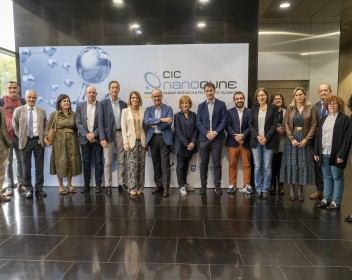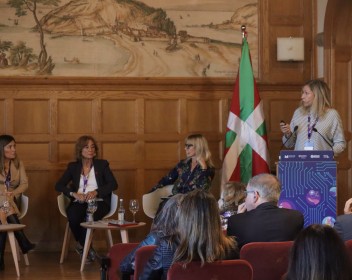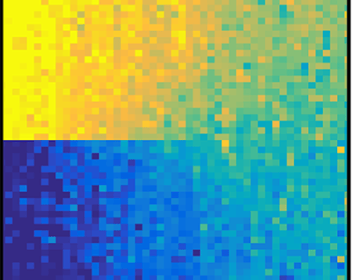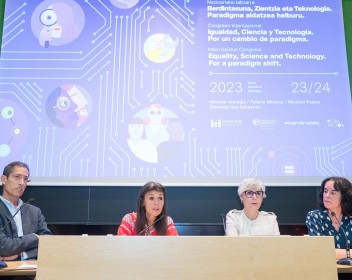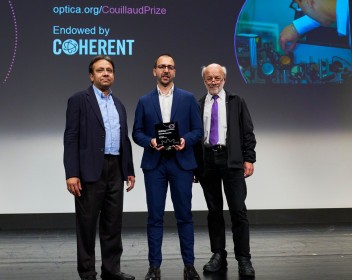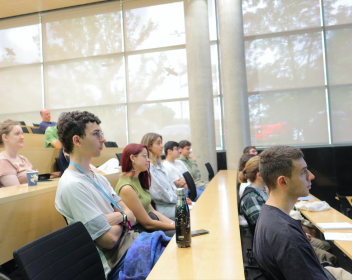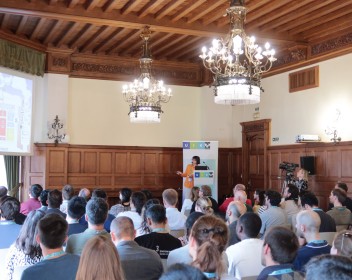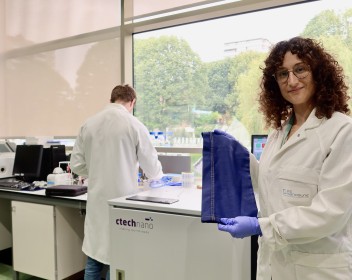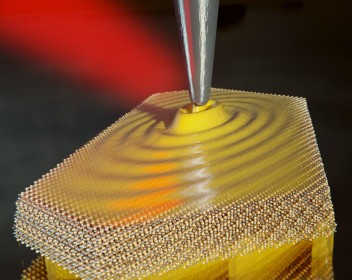Prentsa-bulegoa
Albisteak
Ekipamendu zientifiko berria eskuratu da Eusko Jaurlaritzaren Azpitek programaren esparruan
'Berdintasuna, zientzia eta teknologia. Paradigma aldatzea helburu' nazioarteko biltzarra hasi da
Critical Scaling of Dynamic Phase Transitions in magnetic films
In a recent article published in Physical Review Letters (Phys. Rev. Lett. 131, 116701 (2023)) and selected as an Editor’s suggestion, Mikel Quintana and Andreas Berger from the Nanomagnetism group at nanoGUNE succeeded in experimentally detecting and quantifying critical scaling near the dynamic phase transition (DPT) for the first time.
"Berdintasuna, Zientzia eta Teknologia paradigma aldaketa baten alde" nazioarteko kongresua aurkeztu dute
Nerea Melgosa Berdintasun, Justizia eta Gizarte Politiketako sailburuak eta Miren Elgarresta Emakundeko zuzendariak, Txema Pitarke CIC nanoGUNEko zuzendariak eta Lorena Fernández Deustuko Unibertsitateko nortasun digitaleko zuzendariak lagunduta, nanoGUNEren egoitzan egin den prentsaurrekoan aurkeztu dute urriaren 23an eta 24an Donostiako Miramar Jauregian ospatuko den "Berdintasuna, Zientzia eta Teknologia paradigma aldaketa baten alde" Nazioarteko Kongresua. Iñigo Urkullu Lehendakariak inauguratuko duen kongresu honek nazioarteko adituak bilduko ditu zientziaren eta teknologiaren eremuan emakumeen eta gizonen arteko berdintasuna sistematikoki txertatzeko dauden genero-desberdintasunak eta arrakalak eta beharrezko eraldaketak jorratzeko.
MYRUNS euskal enpresa teknologikoa Evolgene Genomics bioteknologikoaren bazkide nagusi bihurtu da
MYRUNS ENGINEERING SPORTS, SL (MYRUNS) euskal enpresak nanoGUNE ikerketa zentroaren 'Evolgene Genomics ' spinoff-aren %80 eskuratu du. MYRUNS-ek irrati-frekuentzia bidezko identifikazioa (RFID, ingelesezko sigletatik) garatzen du enpresen eraldaketa digitala gauzatzeko. Xabier García Roldán da MYRUNS-en sortzaile eta akziodun nagusia.
Edoardo Vicentini, Bernard J. Couillaud 2023 sariaren irabazlea
Ongi etorria eman diegu udako praktiketako ikasleei!
CIC nanoGUNEk Eremu Hurbileko Nanoskopia Optikoaren lehen Udako Eskola antolatu du
«Nanoirudi optikoak hartzeko tresnak garatu genituenean —s-SNOM eta nano-FTIR—, ez nuen pentsatzen halako aplikazio-potentzial handia izango zutenik», dio Rainer Hillenbrand Ikerbasque irakasleak, ikerketa-arlo horren bilakaerari buruz galdetutakoan. Aste honetan, ekainaren 6tik 9ra, nanoGUNEk Ensemble 3 eta Attocube-rekin batera antolatu duen Eremu Hurbileko Nanoskopia Optikoaren udako eskolak ongietorria emango die teknikei ahalik eta etekin handiena ateratzen ikasteko irrikaz dauden 70 parte-hartzaileei.
CIC nanoGUNE ikerketa-zentroan garatutako teknologia batek berrikuntza sustatzen du ehungintza-sektorean
CIC nanoGUNE nanozientziaren euskal ikerketa-zentroa ehungintzako zuntzak eta ehunak funtzionalizatzeko teknika espezifikoak garatzen ari da. Nanomaterialen taldeak zuzentzen duen etorkizun handiko ikerketa-ildo hau Elkarteken proiektu batean kokatzen da, eta, nanoGUNErekin batera, beste bi erakunde hauek parte hartzen dute: Gaiker zentro teknologikoak (tratatutako oihalen azken propietateak testatzen ditu) eta Andromeda Moto ehungintzako enpresak (oihalak hornitzen ditu).
Researchers observe extremely squeezed directional THz waves in thin semiconductor crystals
An international team of scientists from the Basque research center CIC nanoGUNE, Shanghai University for Science and Technology, Fudan University (Shanghai), Brno University of Technology, University of the Basque Country, Materials Physics Center (CSIC-UPV/EHU), Donostia International Physics Center and the Max Planck Institute for Chemical Physics of Solids (Dresden) has imaged and analyzed THz waves that propagate in form of plasmon polaritons along thin anisotropic semiconductor platelets with wavelengths reduced by up to 65 times compared to THz waves in free space. What´s even more intriguing is that the wavelengths vary with the direction of propagation. Such THz waves can be applied for probing fundamental material properties at the nanometer scale and pave the way to the development of ultra-compact on-chip THz devices. The work has been published in Nature Materials (DOI: 10.1038/s41563-023-01547-8).
Agenda
| Al | As | Az | Og | Or | Lr | Ig |
|---|---|---|---|---|---|---|
|
1
|
2
|
3
|
4
|
5
|
6
|
7
|
|
|
|
|
|
|
|
|
|
8
|
10
|
11
|
12
|
13
|
14
|
|
|
|
|
|
|
|
|
|
|
15
|
16
|
17
|
18
|
19
|
20
|
21
|
|
|
|
|
|
|
|
|
|
22
|
23
|
24
|
25
|
26
|
27
|
28
|
|
|
|
|
|
|
|
|
|
29
|
30
|
31
|
1
|
2
|
3
|
4
|
|
|
|
|
|
|
|
|
Ekitaldiak
- 2026/02/04 - 2026/02/06
nanoGUNE Winter School 2026
nanoTEKA
Aurkitu argazkiak, irudi esperimentalak, bideoak, audioak eta nanoGUNErenirudi korporatiboa.

